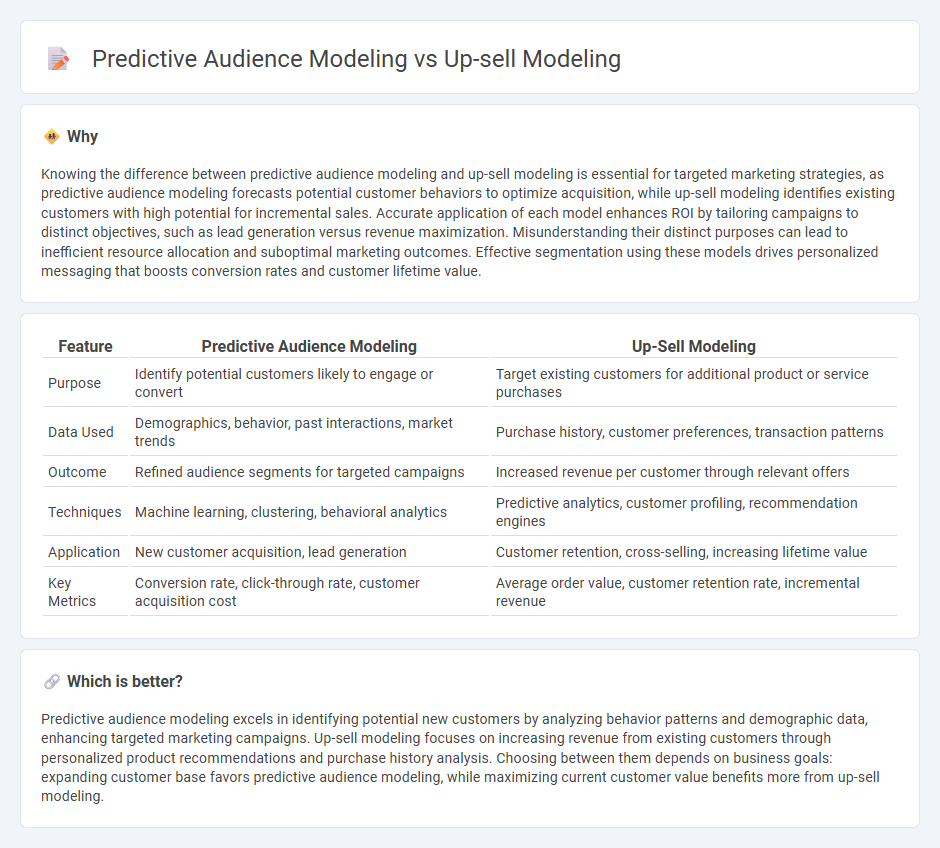
Predictive audience modeling leverages data analytics and machine learning to identify potential customers based on behavior patterns and demographic insights, enhancing targeting precision in marketing campaigns. Up-sell modeling focuses on analyzing existing customer data to predict opportunities for offering higher-value products or upgrades, increasing revenue per customer. Explore more to understand how these models can optimize your marketing strategy and drive growth.
Why it is important
Knowing the difference between predictive audience modeling and up-sell modeling is essential for targeted marketing strategies, as predictive audience modeling forecasts potential customer behaviors to optimize acquisition, while up-sell modeling identifies existing customers with high potential for incremental sales. Accurate application of each model enhances ROI by tailoring campaigns to distinct objectives, such as lead generation versus revenue maximization. Misunderstanding their distinct purposes can lead to inefficient resource allocation and suboptimal marketing outcomes. Effective segmentation using these models drives personalized messaging that boosts conversion rates and customer lifetime value.
Comparison Table
| Feature | Predictive Audience Modeling | Up-Sell Modeling |
|---|---|---|
| Purpose | Identify potential customers likely to engage or convert | Target existing customers for additional product or service purchases |
| Data Used | Demographics, behavior, past interactions, market trends | Purchase history, customer preferences, transaction patterns |
| Outcome | Refined audience segments for targeted campaigns | Increased revenue per customer through relevant offers |
| Techniques | Machine learning, clustering, behavioral analytics | Predictive analytics, customer profiling, recommendation engines |
| Application | New customer acquisition, lead generation | Customer retention, cross-selling, increasing lifetime value |
| Key Metrics | Conversion rate, click-through rate, customer acquisition cost | Average order value, customer retention rate, incremental revenue |
Which is better?
Predictive audience modeling excels in identifying potential new customers by analyzing behavior patterns and demographic data, enhancing targeted marketing campaigns. Up-sell modeling focuses on increasing revenue from existing customers through personalized product recommendations and purchase history analysis. Choosing between them depends on business goals: expanding customer base favors predictive audience modeling, while maximizing current customer value benefits more from up-sell modeling.
Connection
Predictive audience modeling uses data analytics to identify potential customer segments likely to engage with specific products, enhancing targeting accuracy. Up-sell modeling builds on these insights by predicting which customers have the highest propensity to purchase premium or additional products. The integration of both models drives revenue growth by personalizing marketing efforts and optimizing customer lifetime value.
Key Terms
Up-sell Modeling:
Up-sell modeling analyzes existing customer data to identify opportunities for promoting higher-value products or services, enhancing revenue per customer and increasing customer lifetime value. This technique uses machine learning algorithms to predict which customers are most likely to respond to up-sell offers based on purchase history, behavior patterns, and demographic profiles. Discover how up-sell modeling can boost your sales strategy and drive sustainable growth.
Cross-sell Probability
Up-sell modeling predicts the likelihood of customers purchasing higher-value products, enhancing revenue per transaction by targeting segments more inclined to upgrade. Predictive audience modeling focuses on cross-sell probability to identify customers most likely to buy complementary products, optimizing marketing efforts for product bundling and increased customer lifetime value. Explore advanced strategies to leverage these models for maximizing sales opportunities.
Customer Lifetime Value (CLV)
Up-sell modeling targets increasing revenue by identifying current customers most likely to purchase additional products, enhancing short-term Customer Lifetime Value (CLV). Predictive audience modeling uses data-driven insights to forecast long-term CLV, enabling personalized marketing strategies that attract and retain high-value future customers. Explore deeper strategies and methodologies to maximize CLV through advanced modeling techniques.
Source and External Links
Predicting Success for Cross-Sell and Upsell Offers - Upsell modeling uses predictive analytics to identify customers most likely to upgrade their current purchases and suggests the next best offers, optimizing timing and channels to increase conversions and revenue.
Upselling and Cross-selling: Benefits, Strategies, Industrial ... - Upsell modeling employs machine learning models such as Matrix Factorisation and factor analysers on customer transaction data to predict cross-selling and upselling opportunities, optimizing discount assignment and identifying loyal customers for targeted offers.
Uplift modelling - Uplift modeling, related to upsell modeling, focuses on predicting the incremental impact of marketing actions by targeting persuadable customers to improve return on investment and reduce harmful effects like customer churn in campaigns.
 dowidth.com
dowidth.com